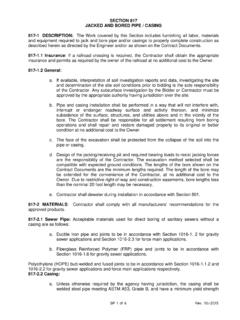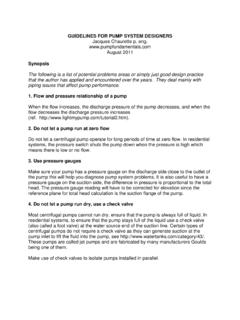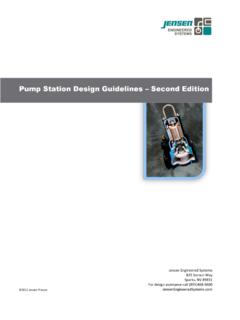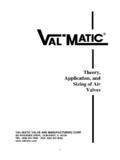Transcription of Pump Station Design Requirements - Baton Rouge
1 Sanitary Sewer Overflow (SSO) Control and Wastewater Facilities Program Pump Station Design Requirements City of Baton Rouge /Parish of East Baton Rouge Department of Public Works Submitted by Prepared by: Ed Prestemon Reviewed by: Larry Fettkether Approved by: Jennifer Baldwin Revision 6. September 2012. Revision Control Log Revision Date Issued Description of Changes Pages Affected 1 8/2009 Revision of Program Requirements All 2 8/2009 Revision of Program Requirements All 3 8/2009 Revision of Program Requirements All 4 9/2010 Revision of Program Requirements All 5 7/2011 Revision of Program Requirements All 6 9/2012 Revision of Program Requirements All iii REV. 6 / SEPTEMBER 2012. Contents Section Page Revision Control Log .. iii v 1. Introduction .. 1-1 2. Codes and Referenced Standards .. 2-1 3. Pump Station Configurations .. 3-1 Pump Station Terminology .. 3-1 C-P Standard Pump Stations .. 3-1 Program Pump 3-1 Large Capacity Pump Stations.
2 3-2 4. Site Selection .. 4-1 Site 4-1 Site Layout .. 4-4 Clearances .. 4-5 Intrusion Protection/Fencing .. 4-5 Access Requirements .. 4-6 Operation and Maintenance 4-6 Landscaping .. 4-6 Grading and Drainage .. 4-6 Pump Wash Down Facility .. 4-7 5. Pump Station Hydraulics .. 5-1 Design Flows .. 5-1 Design Criteria .. 5-1 Number and Size of pumps .. 5-2 Pump Design Conditions .. 5-2 Forcemain and Pump Station Size Selection .. 5-3 Wet Well Volume and Level Controls .. 5-4 Types of Level Controls .. 5-4 Level Control Settings and Wet Well Volume .. 5-4 Surge Analysis .. 5-6 6. Wet Wells .. 6-1 Configurations .. 6-1 Compartmentalized Wet Wells .. 6-1 v REV. 6 / SEPTEMBER 2012. CONTENTS. Section Page 7. Structural 7-1 Geotechnical Coordination .. 7-1 Construction Type .. 7-1 Structural Design Criteria for Program Pump 7-1 Buoyancy .. 7-2 Access Hatches .. 7-2 Handrails .. 7-3 Grating .. 7-3 Wet Well Specialties.
3 7-3 8. Architectural Requirements .. 8-1 Need for Electrical Building .. 8-1 General Building Considerations .. 8-1 Wall Construction .. 8-1 Roof Structure and Roofing Materials .. 8-2 Energy and Insulation .. 8-2 Finishes .. 8-2 Security .. 8-2 Building Access .. 8-2 Doors and Hardware .. 8-2 Louvers .. 8-3 Confined Space Entry .. 8-3 9. Mechanical Requirements .. 9-1 Piping 9-1 Pump Spacing .. 9-1 Pump Selection .. 9-1 Pump Motor Selection Criteria .. 9-2 Pump Removal 9-3 Pump Guide System .. 9-3 Piping Selection and Arrangement .. 9-3 Valve/Gate Selection .. 9-4 Backflow Preventer .. 9-5 Provisions for 9-5 Odor 9-6 Pigging Facilities .. 9-8 Pipe Finishes .. 9-8 Pump Station Layout .. 9-8 10. Ventilating and Air Conditioning Requirements .. 10-1 Design Standards .. 10-1 Area Classifications .. 10-1 Motor Control 10-1 Air Conditioning .. 10-1 Ventilation and Air 10-1 REV. 6 / SEPTEMBER 2012 VI PUMP Station Requirements .
4 Section Page 11. Electrical Requirements .. 11-1 General .. 11-1 Codes .. 11-1 Electrical Service Equipment .. 11-2 Electrical Design , Power Distribution, and Motor Control Requirements .. 11-2 C-P Standard Pump Stations .. 11-2 Program Pump 11-4 Branch 11-5 Conduit System .. 11-6 Conductors .. 11-7 Junction Boxes and Enclosures .. 11-8 Lighting .. 11-8 Grounding .. 11-9 Transient Voltage Surge Suppression .. 11-9 Standby Power Generator System .. 11-9 Generator Design .. 11-9 Generator Permits Description .. 11-11 PDP Pump Station Design Firm Responsibilities .. 11-12 Program Manager Responsibilities to 11-12 12. Instrumentation and Control Requirements .. 12-1 Applicable Codes and Standards .. 12-1 Specific Control Panel and PLC System Design Requirements .. 12-1 C-P Standard Pump Stations (Type I and II) .. 12-1 Program Pump 12-1 PLC and Related Hardware .. 12-2 Piping and Instrumentation Drawings.
5 12-3 12-3 Functional Requirements for Pump Station Control \System/Sequencing .. 12-4 Pump Control/Sequencing for Rising Levels .. 12-4. Pump Control/Sequencing for Falling Levels .. 12-5. Emergency Pump Call Procedure .. 12-5. Pump Alternation .. 12-5. Hardwired Interlock to Prevent Starting of Standby Pump When All Duty pumps are Running .. 12-5. Pump Failed to Start and Out of Service Logic .. 12-6. Interface to Collection System SCADA System .. 12-6 13. Pump Station Commissioning and 13-1 14. Pump Station Design Checklists .. 14-1 Preliminary Design (30%) .. 14-1 60% Engineering 14-1 Final Design and Contract Documents (90% and 100% Design ) .. 14-1. vii REV. 6 / SEPTEMBER 2012. CONTENTS. Attachments A Pump Station Hydraulic Curve(s) Assumptions B Example Pump Station Drawings C Example Electrical Drawings D Example Instrumentation and Control Drawings E Owner Furnished Products Specification F Electrical Load Estimate Sheet G Automatic Transfer Control System Specification H Pump Station Equipment Commissioning Specification and Checklist I Pump Station Design Checklists REV.
6 6 / SEPTEMBER 2012 VIII 1. Introduction This document provides Requirements for the Design of wastewater pump stations associated with the City of Baton Rouge \East Baton Rouge Parish (C-P) Sanitary Sewer Overflow Control and Wastewater Facilities Program. These Requirements are provided to ensure consistency in the Design approach used by the various Engineers, and are intended for use on all applicable projects. While the purpose of the Requirements is to assure uniformity, it is not intended to stifle creativity, Design innovation, and ingenuity of individual Engineers. Engineers shall review these Requirements and adapt them for facility designs for which they are responsible. Engineers are ultimately responsible for their facility's Design , and this responsibility is in no way diluted or absolved by these Requirements . The Engineer may on occasion prefer to deviate from the Requirements . This deviation could be prompted by conflicts in this document, a Design concept, or a feature that the Engineer believes is better or more cost-effective than the suggested remedy, or the development of a new process or equipment.
7 In such cases, the engineer shall immediately bring this matter to the attention of the Program Manager (PM), who will review project-specific deviations. The proposed deviation shall be discussed verbally with the Project Manager within one week from the Engineer's determination of the need for such deviation. The engineer shall also request permission to deviate from the Requirements by completing and submitting the form presented in Attachment A of the Requirements for Engineers. The proposed deviation may be accepted as presented, accepted with identified changes, or not accepted. If the decision cannot be made immediately, the Project Manager will notify the engineer of the turnaround time expected to make a determination on the proposed deviation; this period of time will vary depending on the deviation request. Accepted deviations will also be further considered for possible changes to the program-wide Requirements .
8 The Project Manager reserves the right to disallow the deviation from the Requirements . 1-1 REV. 6 / SEPTEMBER 2012. 2. Codes and Referenced Standards The Design of pump stations and ancillary facilities shall conform to the latest Program Design Requirements and the latest adopted version of all applicable local, state, and federal regulations. Applicable codes and standards and their conditions shall be verified at the time of final Design work. Program Design Requirements are available on the Program web site at 2-1 REV. 6 / SEPTEMBER 2012. 3. Pump Station Configurations Pump Station Terminology The pump stations to be constructed as part of the Program are categorized into three general types: C-P Standard Pump Stations Program Pump Stations Large Capacity Pump Stations Most of the general Requirements included in this document, such as Requirements for pump Station hydraulics and site selection, apply to all three types of pump stations.
9 Most specific Requirements are noted as applying to one or more specific pump Station type. The Engineer shall contact the Project Manager if there are questions concerning the applicability of the Requirements on a specific project. Additional pump Station Design Requirements will be included in the Project Definition. C-P Standard Pump Stations In these Design Requirements , a C-P standard pump Station is defined as one with two or three constant or variable speed pumps installed. All C-P standard pump stations shall be designed as submersible pump stations and shall have a minimum of two rail-mounted pumps (one duty pump and one standby pump) or three rail-mounted pumps (two duty pumps and one standby pump). They shall conform to C-P Standard Specifications and Details. The C-P standard pump stations have been split into two groups. Type I pump stations are duplex and triplex stations that have electrical and controls equipment in a field panel.
10 Type II pump stations are triplex stations that have electrical and controls equipment in an electrical building. Standard pump stations shall also incorporate standby power generation as described in these Requirements . Program Pump Stations In these Design Requirements , a Program pump Station is defined as one with all of the following features: Four, six, or eight pumps Less than or equal to 500 horsepower (hp) per pump Less than 50-foot wet well depth, measured from grade to the top of the bottom slab of the wet well Capacity of 50,000 gallons per minute (gpm) or less 3-1 REV. 6 / SEPTEMBER 2012. 3 PUMP Station CONFIGURATIONS. A minimum of four, variable speed pumps are required for these stations. Firm capacity of pump stations is defined as the capacity of the Station with the largest capacity pump out of service. All Program pump stations shall be designed as variable speed submersible pump stations using rail-mounted pumps with permanently mounted pump base and discharge pipe.








